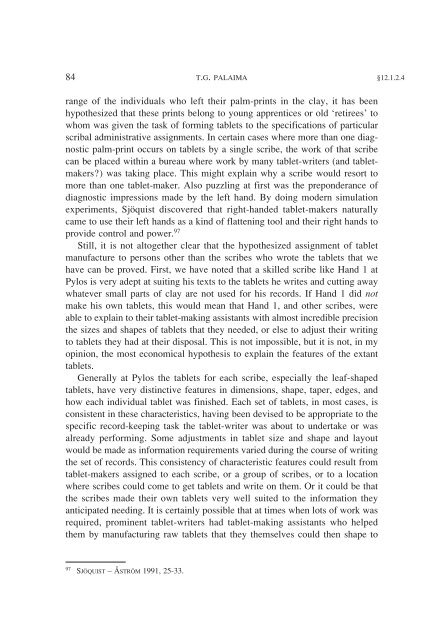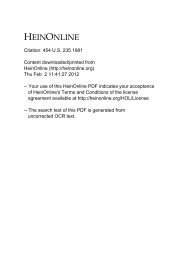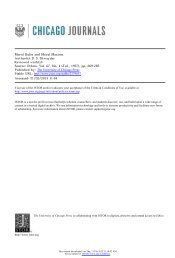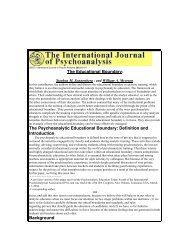A Companion to Linear B - The University of Texas at Austin
A Companion to Linear B - The University of Texas at Austin
A Companion to Linear B - The University of Texas at Austin
Create successful ePaper yourself
Turn your PDF publications into a flip-book with our unique Google optimized e-Paper software.
84 T.G. PALAIMA §12.1.2.4<br />
range <strong>of</strong> the individuals who left their palm-prints in the clay, it has been<br />
hypothesized th<strong>at</strong> these prints belong <strong>to</strong> young apprentices or old ‘retirees’ <strong>to</strong><br />
whom was given the task <strong>of</strong> forming tablets <strong>to</strong> the specific<strong>at</strong>ions <strong>of</strong> particular<br />
scribal administr<strong>at</strong>ive assignments. In certain cases where more than one diagnostic<br />
palm-print occurs on tablets by a single scribe, the work <strong>of</strong> th<strong>at</strong> scribe<br />
can be placed within a bureau where work by many tablet-writers (and tabletmakers?)<br />
was taking place. This might explain why a scribe would resort <strong>to</strong><br />
more than one tablet-maker. Also puzzling <strong>at</strong> first was the preponderance <strong>of</strong><br />
diagnostic impressions made by the left hand. By doing modern simul<strong>at</strong>ion<br />
experiments, Sjöquist discovered th<strong>at</strong> right-handed tablet-makers n<strong>at</strong>urally<br />
came <strong>to</strong> use their left hands as a kind <strong>of</strong> fl<strong>at</strong>tening <strong>to</strong>ol and their right hands <strong>to</strong><br />
provide control and power. 97<br />
Still, it is not al<strong>to</strong>gether clear th<strong>at</strong> the hypothesized assignment <strong>of</strong> tablet<br />
manufacture <strong>to</strong> persons other than the scribes who wrote the tablets th<strong>at</strong> we<br />
have can be proved. First, we have noted th<strong>at</strong> a skilled scribe like Hand 1 <strong>at</strong><br />
Pylos is very adept <strong>at</strong> suiting his texts <strong>to</strong> the tablets he writes and cutting away<br />
wh<strong>at</strong>ever small parts <strong>of</strong> clay are not used for his records. If Hand 1 did not<br />
make his own tablets, this would mean th<strong>at</strong> Hand 1, and other scribes, were<br />
able <strong>to</strong> explain <strong>to</strong> their tablet-making assistants with almost incredible precision<br />
the sizes and shapes <strong>of</strong> tablets th<strong>at</strong> they needed, or else <strong>to</strong> adjust their writing<br />
<strong>to</strong> tablets they had <strong>at</strong> their disposal. This is not impossible, but it is not, in my<br />
opinion, the most economical hypothesis <strong>to</strong> explain the fe<strong>at</strong>ures <strong>of</strong> the extant<br />
tablets.<br />
Generally <strong>at</strong> Pylos the tablets for each scribe, especially the leaf-shaped<br />
tablets, have very distinctive fe<strong>at</strong>ures in dimensions, shape, taper, edges, and<br />
how each individual tablet was finished. Each set <strong>of</strong> tablets, in most cases, is<br />
consistent in these characteristics, having been devised <strong>to</strong> be appropri<strong>at</strong>e <strong>to</strong> the<br />
specific record-keeping task the tablet-writer was about <strong>to</strong> undertake or was<br />
already performing. Some adjustments in tablet size and shape and layout<br />
would be made as inform<strong>at</strong>ion requirements varied during the course <strong>of</strong> writing<br />
the set <strong>of</strong> records. This consistency <strong>of</strong> characteristic fe<strong>at</strong>ures could result from<br />
tablet-makers assigned <strong>to</strong> each scribe, or a group <strong>of</strong> scribes, or <strong>to</strong> a loc<strong>at</strong>ion<br />
where scribes could come <strong>to</strong> get tablets and write on them. Or it could be th<strong>at</strong><br />
the scribes made their own tablets very well suited <strong>to</strong> the inform<strong>at</strong>ion they<br />
anticip<strong>at</strong>ed needing. It is certainly possible th<strong>at</strong> <strong>at</strong> times when lots <strong>of</strong> work was<br />
required, prominent tablet-writers had tablet-making assistants who helped<br />
them by manufacturing raw tablets th<strong>at</strong> they themselves could then shape <strong>to</strong><br />
97 SJÖQUIST – ÅSTRÖM 1991, 25-33.

















